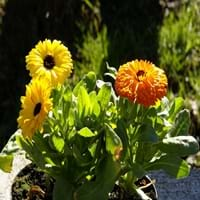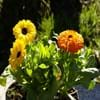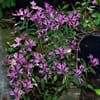Life Span
Perennial
Perennial
Type
Flowering Plants
Vegetable
Origin
Europe, Mediterranean
Mexico, Central America, South America
Types
Kablouna Gold, Fiesta Gitana, Art Shades
Bigleaf hydrangea, Hortensia, Smooth hydrangea, Oakleaf hydrangea, Annabelle
Number of Varieties
Not Available
Habitat
gardens, Roadsides, Waste areas, wastelands
Forest edges, Hillside, Woods
USDA Hardiness Zone
3-9
11-15
Sunset Zone
A2, A3, H1, 1a, 1b, 2a, 2b, 3a, 3b, 4, 5, 6, 7, 8, 9, 10, 11, 12, 13, 14, 15, 16, 17, 18, 19, 20, 21, 22, 23, 24
21,22
Habit
Clump-Forming
Vining/Climbing
Flower Color
Yellow, Orange, Bronze, Ivory
Yellow
Flower Color Modifier
Bicolor
Bicolor
Fruit Color
Green, Tan
Yellow, Orange Red
Leaf Color in Spring
Green
Green, Dark Green
Leaf Color in Summer
Green
Green, Dark Green
Leaf Color in Fall
Green
Green, Dark Green
Leaf Color in Winter
Light Green
Green, Dark Green
Leaf Shape
Oblong-lanceolate
Oblovate
Plant Season
Early Autumn, Spring, Summer
Spring, Summer, Fall
Sunlight
Full Sun, Partial shade, Partial Sun
Full Sun
Type of Soil
Well drained
Loam, Sand
The pH of Soil
Acidic, Alkaline, Neutral
Neutral
Soil Drainage
Average
Well drained
Bloom Time
Early Winter
Indeterminate
Tolerances
Drought
Drought
Where to Plant?
Ground, Pot
Container, Ground
How to Plant?
Seedlings, Transplanting
Seedlings, Stem Planting
Plant Maintenance
Medium
Medium
Watering Requirements
Requires regular watering
Not Available
In Summer
Lots of watering
Average Water
In Spring
Moderate
Moderate
In Winter
Average Water
Average Water
Soil pH
Acidic, Alkaline, Neutral
Neutral
Soil Type
Moist, Well drained
Loam, Sand
Soil Drainage Capacity
Not Available
Well drained
Sun Exposure
Partial shade
Full Sun
Pruning
Cut or pinch the stems, Remove damaged leaves, Remove dead branches, Remove dead leaves
Remove damaged leaves, Remove dead branches, Remove dead leaves
Fertilizers
All-Purpose Liquid Fertilizer
All-Purpose Liquid Fertilizer
Pests and Diseases
Red blotch
Red blotch
Plant Tolerance
Drought
Drought
Flower Petal Number
Double, Semi-Double
Single
Fragrant Bark/Stem
No
Yes
Foliage Texture
Medium
Medium
Foliage Sheen
Matte
Matte
Evergreen
No
Semi-Evergreen
Attracts
Beetles, Butterflies, Flying insects
Butterflies
Allergy
Dizziness, Itchiness, Nausea, Skin rash, Swelling
Chest tightness, Diarrhea, Dizziness, Nausea, Vomiting
Aesthetic Uses
Showy Purposes
Not Available
Beauty Benefits
Good for skin and hair, Skin cleanser, Skin Problems, used as a dye
Not Available
Edible Uses
Yes
Not Available
Environmental Uses
Air purification
Air purification
Medicinal Uses
Curing mumps and measles, Cuts, Reduces toothache, Surgical wounds, Throat infection, Ulcers
Fever, Kidney problems, Urinary tract problems
Part of Plant Used
Flowers, Leaves, Root
Flowers, Root
Other Uses
Cosmetics, Sometimes used for making wine, Used as an insecticide, Used as essential oil, Used As Food, Used as Ornamental plant, Used in salads
Not Available
Used As Indoor Plant
Insignificant
Not Available
Used As Outdoor Plant
Yes
Yes
Garden Design
Groundcover, Showy Tree
Edible, Herb / Vegetable
Botanical Name
CALENDULA officinalis
LYCOPERSICON esculentum 'Striped German'
Common Name
Pot Marigold
Striped German Tomato
In Hindi
Pot Marigold
Hydrangea
In German
Ringelblume
Hortensie
In French
pot Marigold
Hortensia
In Spanish
Caléndula
Hortensia
In Greek
καλέντουλα
υδραγεία
In Portuguese
pot Marigold
Hortênsia
In Polish
Pot Marigold
Hortensja
In Latin
Zinnia Pot
Hibiscus
Phylum
Vascular plant
Not Available
Class
Magnoliopsida
Not Available
Order
Asterales
Not Available
Family
Asteraceae
Solanaceae
Genus
Calendula
Not Available
Clade
Angiosperms, Asterids, Eudicots
Not Available
Tribe
Calenduleae
Not Available
Subfamily
Asteroideae
Not Available
Number of Species
Not Available
Properties of Pot Marigold and Striped German Tomato
Wondering what are the properties of Pot Marigold and Striped German Tomato? We provide you with everything About Pot Marigold and Striped German Tomato. Pot Marigold doesn't have thorns and Striped German Tomato doesn't have thorns. Also Pot Marigold does not have fragrant flowers. Pot Marigold has allergic reactions like Dizziness, Itchiness, Nausea, Skin rash and Swelling and Striped German Tomato has allergic reactions like Dizziness, Itchiness, Nausea, Skin rash and Swelling. Compare all the properties and characteristics of these two plants. Find out which of these plant can be used as indoor plant. If you are interested to decorate your house and garden, find out aesthetic uses, compare them and select the plant which will beautify your surrounding. Along with beautification, try comparing medicinal and edible uses of Pot Marigold and Striped German Tomato and you can choose the plant having best and most benefits.
Season and Care of Pot Marigold and Striped German Tomato
Season and care of Pot Marigold and Striped German Tomato is important to know. While considering everything about Pot Marigold and Striped German Tomato Care, growing season is an essential factor. Pot Marigold season is Early Autumn, Spring and Summer and Striped German Tomato season is Early Autumn, Spring and Summer. The type of soil for Pot Marigold is Well drained and for Striped German Tomato is Loam, Sand while the PH of soil for Pot Marigold is Acidic, Alkaline, Neutral and for Striped German Tomato is Neutral.
Pot Marigold and Striped German Tomato Physical Information
Pot Marigold and Striped German Tomato physical information is very important for comparison. Pot Marigold height is 80.00 cm and width 91.44 cm whereas Striped German Tomato height is 60.00 cm and width 60.00 cm. The color specification of Pot Marigold and Striped German Tomato are as follows:
Pot Marigold flower color: Yellow, Orange, Bronze and Ivory
Pot Marigold leaf color: Green
Striped German Tomato flower color: Yellow
- Striped German Tomato leaf color: Green and Dark Green
Care of Pot Marigold and Striped German Tomato
Care of Pot Marigold and Striped German Tomato include pruning, fertilizers, watering etc. Pot Marigold pruning is done Cut or pinch the stems, Remove damaged leaves, Remove dead branches and Remove dead leaves and Striped German Tomato pruning is done Remove damaged leaves, Remove dead branches and Remove dead leaves. In summer Pot Marigold needs Lots of watering and in winter, it needs Average Water. Whereas, in summer Striped German Tomato needs Average Water and in winter, it needs Average Water.





